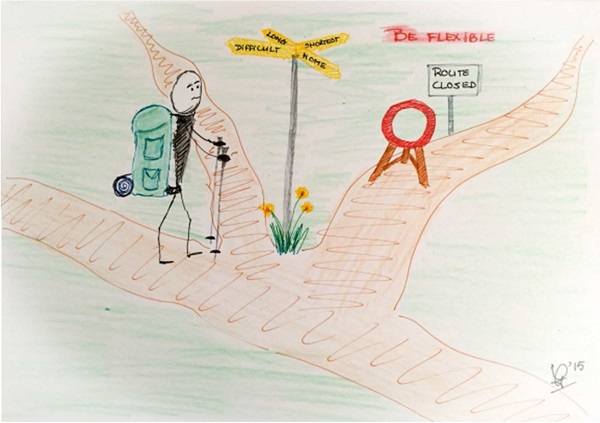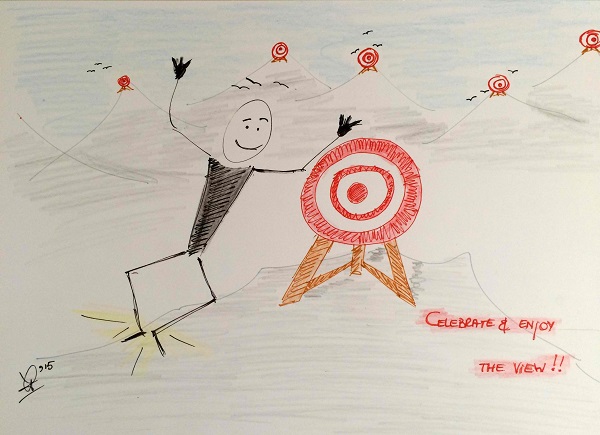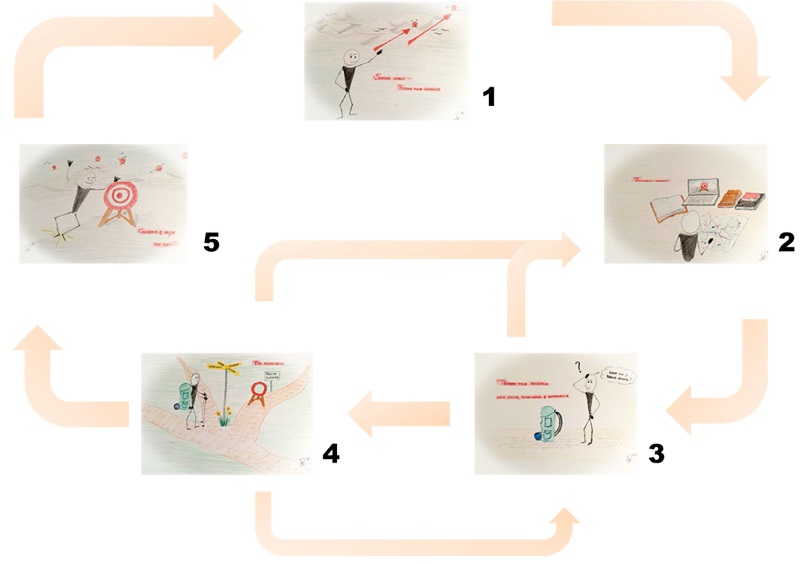Through this exploration he becomes aware of patterns in his life, decisions as well as actions. It is also the phase in which issues that he wants or needs to overcome are identified by him.
Step 3 – Pack your backpack (or take action)
 The summit has been chosen. Necessary knowledge, experience and skills have been identified. It is time to take action.
The summit has been chosen. Necessary knowledge, experience and skills have been identified. It is time to take action.
During the coaching process the client has become aware of all the knowledge, experience, skills, values and more he has gathered over his life and during the coaching process.
He carries all these in his ‘backpack’ and is prepared to set out on his chosen trail to reach his ‘summit’.
Step 4 – Be flexible
 As with mountain hiking, sometimes things don’t go as planned. We come to forks in the trail and may find that the one we planned on taking has been closed off. Or there appears to be a never considered alternative. Or the trail, we’ve chosen, turns out to exceed our capabilities. This is when we need to be flexible.
As with mountain hiking, sometimes things don’t go as planned. We come to forks in the trail and may find that the one we planned on taking has been closed off. Or there appears to be a never considered alternative. Or the trail, we’ve chosen, turns out to exceed our capabilities. This is when we need to be flexible.
While on his way to his chosen ‘summit’ it can, and most likely will, happen that the client runs into unexpected obstacles on his chosen ‘trail’.
It is then that he gets to explore alternative ‘trails’. Does he go for the more difficult one, the less direct one or does he perhaps even retrace at least some of his steps? Are there other possibilities still that are worth exploring?
Step 5 – Celebrate and enjoy the view
 Whatever the eventual path leading to the client’s goal looks like, once he has summited his mountain peak, it is time for a big celebration. Having worked hard to accomplish his goal, he gets to enjoy his accomplishment fully and, of course, enjoy the view.
Whatever the eventual path leading to the client’s goal looks like, once he has summited his mountain peak, it is time for a big celebration. Having worked hard to accomplish his goal, he gets to enjoy his accomplishment fully and, of course, enjoy the view.
‘Summiting’ a hard fought mountain, reaching a challenging goal, is a major milestone in a client’s life. It can totally open up his horizon and can completely change his perspective.
After all, the view from the summit is decidedly different from that way down below in the valley. It is even completely different from the views seen while working towards the goal the client has set himself.
While standing on his ‘summit’ and looking around him, he often realizes many more ‘summits’ have come into view. Those ‘summits’ can represent new goals. Goals that, with the experience and knowledge gathered on his journey to the summit he is standing on, have now become a very real possibility.
Having taken ample time to celebrate his accomplishment, the client can decide on his next goal(s) and start on a new ‘hike’.
The hiking model
 Coaching, like life or mountain hiking, is not a linear process. Experiences, circumstances and many other factors may necessitate reconsidering earlier decisions or conclusions.
Coaching, like life or mountain hiking, is not a linear process. Experiences, circumstances and many other factors may necessitate reconsidering earlier decisions or conclusions.
While packing his ‘backpack’ the client may come to the conclusion, he lacks certain knowledge or experience and therefore more research is needed.
While on the trail towards his chosen ‘summit’, he may discover obstacles in his way, that force him to take another trail, add certain skills or knowledge to his ‘backpack’ or even compel him to go back and do more research.
Knowing when to retrace your steps and/or try a different approach is an important skill in mountain hiking. It is no less important in life.
These instances are therefore no cause for disillusionment. They are in fact cause for celebration. After all, the client is not giving up on his desire to reach his stated goal. He has simply gained insight into himself, into his values, capabilities and more. He is simply looking for a different approach.
Daring greatly
In the end it is not whether or not the client reaches the particular ‘summit’ he sets himself at the beginning of his coaching journey (although that is, of course, important).
What matters is that he sets his sights on summits, researches how they can be reached, packs his backpack and sets out on the trail.
What matters is that he experiences not just the valleys, but also the climbs out of them and enjoys the views that come with those climbs.
What matters is that he experiences there can be a descent after a long climb, but that there always is another climb that can take him where he wants to go.
What matters is that he is daring greatly!
The Man in the Arena
It is not the critic who counts; not the man who points out how the strong man stumbles, or where the doer of deeds could have done them better.
The credit belongs to the man who is actually in the arena, whose face is marred by dust and sweat and blood; who strives valiantly; who errs, who comes short again and again, because there is no effort without error and shortcoming; but who does actually strive to do the deeds; who knows great enthusiasms, the great devotions; who spends himself in a worthy cause; who at the best knows in the end the triumph of high achievement, and who at the worst, if he fails, at least fails while daring greatly, so that his place shall never be with those cold and timid souls who neither know victory nor defeat. ~ Theodore ‘Teddy’ Roosevelt ~